Taking a look at the map, our redoubtable Ford Popular must have continued its 1954 road trip along the valley from St Moritz heading southwest towards the border whereupon it, and my father and grandfather, will have crossed into Italy. En route, they spotted a ‘Swiss peasant’ laden down with straw (or hay). Not quite the Switzerland that the staff at Going Postal recall; a place and time will shall come to eventually.
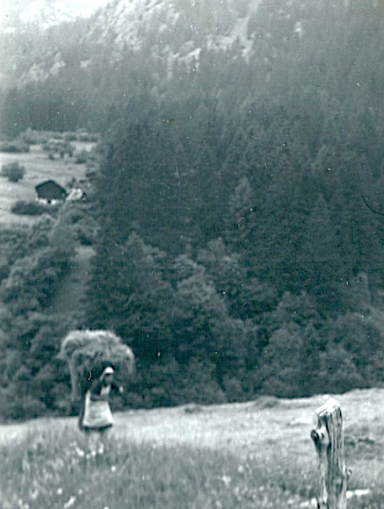
© Always Worth Saying 2022, Going Postal
If you’re wondering how this humble travel correspondent compiles these articles, like many things in life it is more difficult than it looks. The family album photos, taken before the invention of that helpful thing called the internet and the instrument of instant reproduction known as digital photography, was compiled long after the trip and occasionally with the pictures in the wrong order. Some were wrongly captioned or properly captioned but referring to places whose names have changed.
There must be order!
Therefore, each page of the album has been allocated a colour. A giant wall map of Switzerland (similar to that above the ticket office at Genève Cornavin) is peppered with coloured pins according to the location where the photographs really were taken. Boxes have been drawn around groups of adjoining pins to separate images into episodes. That’s how I know which scanned pictures to use each week. The quality of the photos has improved in recent episodes as the new Mac is a whizz with the scanner. Previously, I had to use an old mobile phone which took iffy pictures often spoiled by a reflection or a shine.
I hope I’m not spoiling the mystery!

Gare de Genève-Cornavin après rénovation,
MHM55 – Licence CC BY-SA 4.0
On reaching Chiavennathey the party headed south to Lake Como. After following the lakeside road to Menaggio they broke their journey and took two photographs outside the Hotel Principe. To give Lake Como some context, it is about 30 miles long at its longest stretch whereas our own Lake Windemere is about 10. The Principe building is still there but no longer a hotel. It appears to be a private residence or residences. Very nicely restored, it’s waterfront location makes it easy to find, not least because of big spikes seen protruding from the roof. A hedge has replaced the street cafe beside which, I suspect, my grandmother can be seen standing clothed in a white dress and dark cardigan.
With the presence of the ice cream pedicar in both photos, we can assume they were taken together but in opposite directions. Sure enough, via Street View, we can see the fancy ironwork fence is still in place as is a lampost which turns out to be one of two guarding a water taxi jetty. The trees have not only survived but thrived and unfortunately block the view. The white post between the ice cream seller and his wares has survived too, although now banded in light blue. Given that another two similar posts are beside the jetty, we shall confer upon them a nautical role.
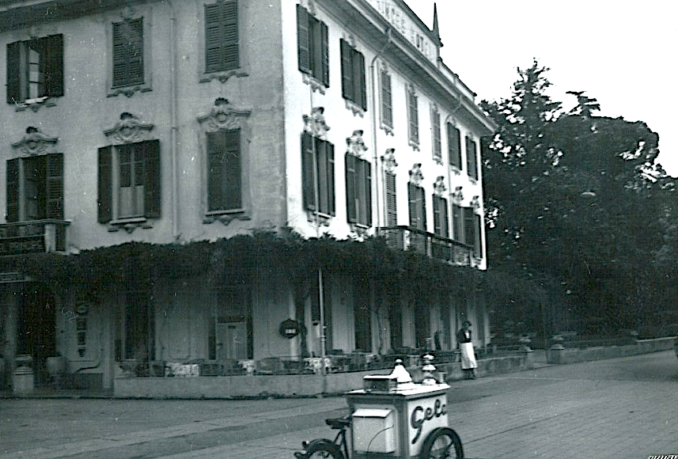
© Always Worth Saying 2022, Going Postal
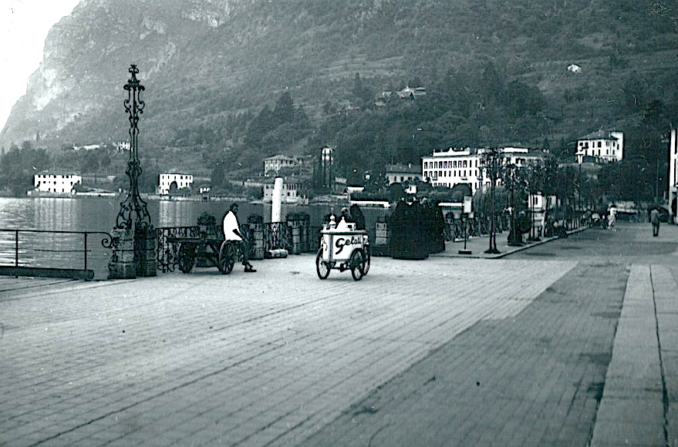
© Always Worth Saying 2022, Going Postal
Before the trees intervened, the view was dominated by a long white building, still extant, but augmented by extended wings. This is the Grand Hotel Menaggio, formally known as the Hotel Menaggio. Surprisingly, given the unhelpful presence of steep mountainsides and a lake, beside the hotel sat Managgio railway station, also still standing.
The Menaggio – Porlezza Railway was a steam-hauled narrow gauge line built as part of a multi modal (ferries and trains) link between Menaggio and Luino on Lake Maggiore, 23 miles away as the crow flies. The old railway station has not only survived but looks well. A 2006 photograph showed it rather shabby but on Street View it has had a lick of paint and makes itself useful as the local Consorzio Agrario.
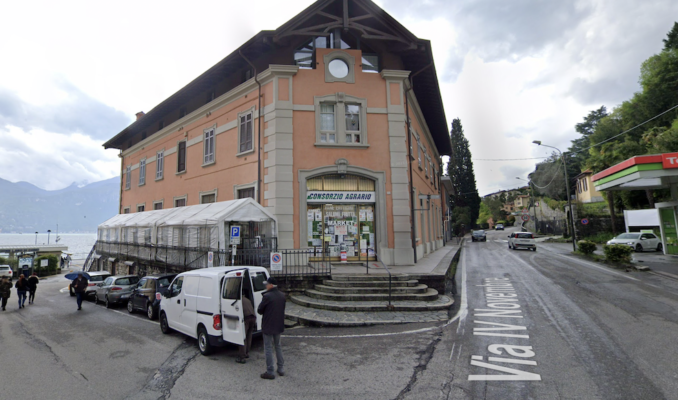
© Google Street View 2022, Google
There is much to take in from the Street View vista. To the left is a jetty for ferry passengers and in the centre is the actual station. Note the original wooden roof. The terminus didn’t house trackwork, that was to the right where the filling station is now. In the distance, where the 30 kmph road sign sits, is the trackbed of the old line. Two pathways can be seen, both now footpaths. The one on the top is the original footpath and the one on the bottom is the old rail route’s 1/20 climb out of Menaggio.
You can have a closer look around via this link.
“What?” I hear you cry, “but Porlezza is in the opposite direction.” Indeed. The climb out of Menaggio is so steep that it required a switchback part way up the mountainside, as if in the Andes. The route can still be made out on satellite images. The old trains advanced for 800m to what is now the Piccolo Girsoli and then stopped on a 150m long section of track. Then they reversed direction and commenced a similarly steep climb which allowed access to the western side of the valley that runs towards Porlezza. This, as in the Andes, avoids the need for a giant rising curve and tunnel.
Judging by the gradient profile which, annoyingly for Alex Scott, Eniola Aluko and Nadia Nadim, doesn’t have the gradients written on, the line continued at 1/20 for 4km to a 384m summit at Granodola. The aforementioned baffled female football commentators would have calculated an average climb of 1/10 (gradient is run divided by rise, ie 4000m/384m) but every gentleman knows that the surface of Lake Como sits 199m above sea level. Therefore, the average gradient is ((384-199)/4,000) which confirms the 1/20. Rising and falling trackbeds are a man’s game. Added to which, for once, although I hate myself for having to say it, the calculation is easier in meters than in miles and chains and feet.
Although my Ian Allen BR Main Line Gradient Profiles book is buried somewhere in an attic crowded by early middle and a big family, for context the steepest gradients I can recall here (both on the Southern) were Folkestone Harbour to Folkestone at 1/32 and 1/37 from Exeter Central to Exeter St Davids. Both stretched for about a mile. Closer to home, the climb to Shap Summit sounds a breeze at 1/75 but lasts for several miles and handles much heavier trains. Pedants below the line, please feel free to correct me in unread comments.
My father and grandparents will have followed a similar route by road and will also have reached Lake Lugano at Porlezza. There, a long, straight Via Prati with an accompanying and revealingly wide footpath suggests that to be the route of the old railway.
At a suspiciously narrow-gauge-steam-line-like bridge, the road becomes Via Ferrovia all the way to the point on Lake Lugano where a present-day jetty announces where intermodal passengers would have disembarked and taken a ferry down the lake to the town of Lugano.
By road, my family will have followed the northern shore in direzione Switzerland along a single-carriageway road interrupted by tunnels and villages. That road was originally known as the Gandria and wasn’t completed until 1936, only 18 years before our family visit. At the time, the newspapers reported,
The Gandria road connecting Lugano, Canton Ticino, and Menaggio on Lake Como, has been opened to traffic. It skirts Lake Lugano, passes through Castagnola, and rises on the steep sides of Monte Bre, leaving untouched the Gandria path as well as the picturesque fishing village of Gandria, one of the beauty spots of Canton Ticino.
The new road didn’t complement the railway line, rather it killed it off with government approval for its closure being granted in 1939. Delayed by the outbreak of war, and post-war attempts to re-develop the route for tourism meant that the disposal of the trackbed and buildings wasn’t finally completed until 1966.

© Always Worth Saying 2022, Going Postal
The above photo should be easy to place with a lakeside footpath shown aside shadow-casting railings. A grass park of young trees is to the left. The mountainous horizon is very distinctive and easy to find. The exact spot is less so. We shall assume it is close to the border post where Italy’s Strada Statale 340 becomes Switzerland’s Via Cantonale. One of the world’s great customs posts stands there. Not at all like the roomy facilities we encountered at the top of the Brenner Pass or at Tubre, a single carriageway runs on the shoreside with the customs post in the lake with a half-arched concrete rockfall tunnel protecting the road.
Have a look around via this link while trying to ignore the modern tunnel.
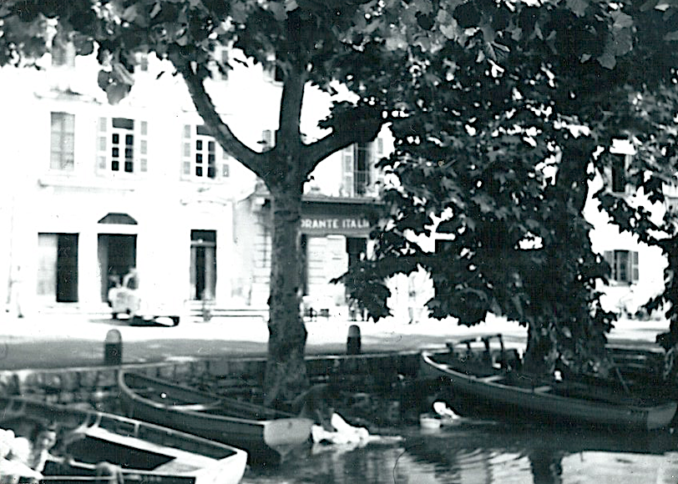
© Always Worth Saying 2022, Going Postal
After the frontier lies a pleasant four-mile trip to the centre of Lugano. We arrive on washing day. The girl in the bottom left corner of the photo looks towards the camera. Another two ladies can be seen to her right. In the gloom they are only noticeable from their white washing. At least one light-coloured basket sits between them. Behind is the Restorante Italiano. Beside them, trees grow out of the water. The waterfront has since been ‘improved’ and few trees still emerge from the lake.
Lugano railway station is a pleasant walk from the lakeside. There our intermodal travellers would have a circuitous but scenic run to Lake Maggiore’s Luino with a change of train at Cadenazzo (one suspects). Those in a hurry might proceed by a more direct bus route along the valley of the River Tresa.
Although my father and grandparents keep their bragging rights, I can shoehorn myself to the other, Piedmont, bank of Lake Maggiore. Four decades ago the evening express returning to Berne from Milan followed that route. Passing the lakeside at tea time, one might find oneself in the dining car admiring the setting sun across the waters. By the Simplon Tunnel, it would be dusk. Twelve and a half miles later, after thundering through the opposite portal at Brig, the night was pitch black. Pin sharp lights defined the hamlets about the slopes of the Upper Valais as a Contessa opposite folded my crisp Swiss Francs and concealed them to her décolletage after another of my naively strategised hands of Canasta. Different times.
Likewise back in the photograph, although the door to the left of the restaurante is distinctive, numerous of the old buildings have been replaced and those that remain have more modern ground floor frontages, many as high-end retailers of luxury goods. We shall assume the restaurant, like the washerwomen of Lake Lugano, to be a ghost from a world now lost.
Further reading
© Always Worth Saying 2022



